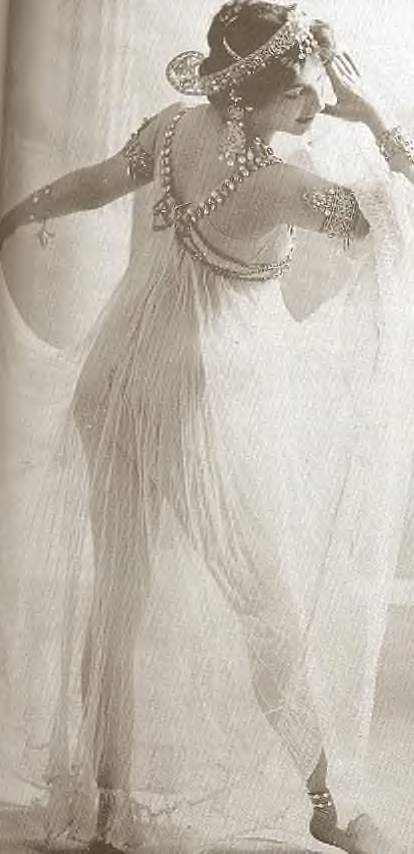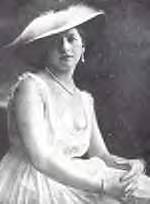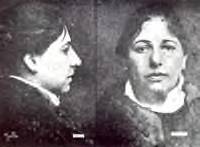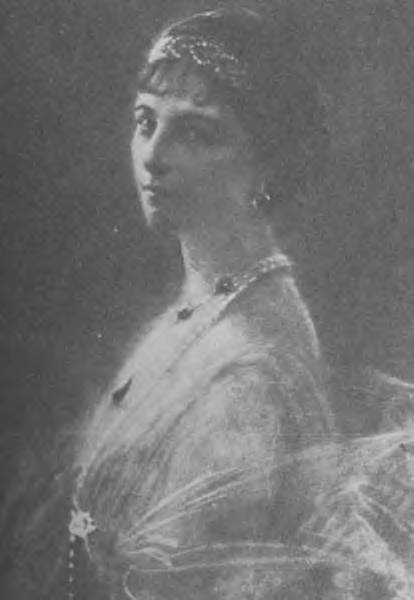|
|
 |
 |
|
Dance of the Dawn The life and Death of Mata Hari
by Monique Monet |
|
|
 |
 |
|
Finally the Mata Hari fad began to wane. It seemed that everyone who wanted to had seen her,
time and time again, performing her innocent-yet-sensual nude dances amid tendrils of incense and statues of Siva and Kali. And new dancers with fresh gimmicks were arriving on the Paris scene everyday. The
public was loosing its fascination with the now tiresome temple dancer. This description by the novelist and dancer Colette exemplifies Parisian society's increasingly critical viewpoint.
"Suddenly, from behind a screen of foliage, Mata Hari appeared, naked, and riding a white horse. The fashionable public had seen a supple torso, a proud and agile back, muscular
loins, long thighs and |
|
 |
 |
|
| |
shin knees . . . . In the May sunshine, at Neuilly however, despite the turquoises and the black
loose mane of hair, despite the diadem made of tinsel, despite, above all, the long thigh against the flank of her Arabian steed, she disconcerted one by the color of her skin which was no longer brown and
luscious as in artificial light, but a dubious, uneven purple." |
| |
|
| |
Shortly thereafter, perhaps with a worried eye on her own future, Mata
Hari made an appearance at The Old Actors Home where she complained, "Ladies styling themselves as Eastern Dancers have sprung out of the ground and honor me with their imitations. I would feel highly
flattered with this mark of attention, if these ladies' performances were accurate from a scientific and aesthetic point of view. But they are not." |
| |
|
| |
Although she had often mentioned her dislike for Germany and swore she would never perform
there, as her popularity declined in Paris she was excited by an opportunity to perform in Berlin. She had always longed to be accepted in legitimate theater. And the fact that, in the prime of her career,
she had been rebuffed by The Ballets Russes was a constant source of disappointment to her. So when she was offered a role in an Egyptian ballet in Berlin, she was ecstatic. But just four weeks before
opening night, World War erupted and Berlin's Metropol Theatre was closed. Mata Hari's career spiraled downwards. Europe had no interest in a nearly middle-aged, nude, fake
Eastern temple dancer. Her last documented performance was described by the writer Misa Sert, when he and international playboy Boni de Castellane went to see the legendary Mata Hari for a private show:
"The car took us for quite a long way before it stopped outside a sordid-looking house in the Paris suburbs. We were asked to go to the first floor, to a bedroom that reeked of
poverty. Four little Hindus in turbans were squatting on the floor, picking at guitars. At last, dressed in three triangles of jewel paste, the expected wonder appeared . . . . Mata Hari! She was a trite
night-club dancer, whose art consisted in showing her body. The musicians frantically twanged at their guitars. The whole thing was grim, miserable and rather nauseating." |
| |
|
| |
Althought her career as a dancer had grossly deteriorated Mata Hari was
still a beautiful woman and a celebrity. She continued to travel and enjoy a lavish lifestyle, although increasingly dependent on the generosity of male friends. |
|
|
|
 |
 |
|
Throughout
her life she had a fascination with men in uniform. And the war caused the world around her to become an exceedingly fascinating place. She was a companion to many high ranking military men from various
nations. And this, paired with the increasing conservatism of war-time society, lead to her final downfall. In happier times she had been generally |
|
 |
 |
|
viewed as an artist, a free-spirited bohemian. But as the times grew more grim she began to be seen by some as a wanton and
promiscuous woman, perhaps a dangerous seductress. At her trial it was revealed that the military had been watching her for years. Disapproving, moral-majority-like officers in the French army had been keeping records on where she performed her nude dances, at whose chateau she spent the week, and so on. |
|
|
 |
 |
|
When they arrested her in February 13, 1917, France was at a low point in the war. Morale was
down - - and there was hunger for a scapegoat. Why was France loosing the war? Because the lust-filled and immoral Mata Hari |
|
 |
 |
|
| |
was worming secrets from trusting French officers and passing those secrets on to her Hun
lovers. |
| |
|
| |
The newspapers announced, "Mata Hari, A Spy!" and the
war-crazed populous was ready to accept it as gospel. Her trial was biased, inaccurate, and flawed from the onset. Those who had originally invented the concept of Mata Hari the spy
(as an excuse to act as paid voyeurs on the trail of a beautiful and fascinating woman) were now also forced to invent substantiating evidence (for example, Mata Hari's attendance at spy school) to protect themselves.
The dirty little snowball had become an avalanche. The sensational trial sold countless newspapers and magazines as those who had once applauded her, now practically blamed her
for the world war. Caught in a dark riptide of history, Margaretha Zelle, in reality guilty of nothing more than having an active imagination and the energy to make her wildest
dreams come true, was condemned as an international spy and sentenced to death. In years to come many would regret their participation in the murder of Mata Hari. Witnesses
recanted their testimony. Friends who new the truth condemned themselves for not coming forward. The man who master-minded the case against her, French Army Commandant Ladoux, was himself arrested and
convicted as a spy in 1918. Even the militaries Inquisitor General, Pierre Bouchardon, a decade later on a radio interview, said of Mata Hari, "She didn't deserve to be executed."
At dawn, on October 15, 1917 Mata Hari, Eye of The Dawn, was taken to the bleak calvary maneuvers ground at Vincennes to be executed. Throughout her life
she may have been a con woman, an exhibitionist, certainly self-obsessed, and perhaps in reality a mediocre dancer. But in her last moments she proved beyond doubt to be a woman of incredible strength and
courage. |
|
|
|
 |
 |
|
Standing alone she
faced twelve infantrymen armed with high- powered rifles. She refused the offer of being tied to a stake. (Many condemned prisoners become weak-kneed or |
|
 |
 |
|
faint when about to be killed.) She stood on her own two feet as she also refused the officer's
offer of a blindfold |
| |
|
| |
As he raised his sword and instructed his troops to, "ready your
rifles- - take aim . . . ." she smiled and blew a kiss to her firing squad. One soldier fell to the ground in a faint. But each of the remaining eleven men aimed his rifle at her graceful body and
pulled the trigger. |
|
 |
 |
|
Mata Hari 1876 -1917 |
|
|
 |
 |
|
Dance Of The Dawn was originally published in Jareeda Magazine. |
 |
 |
|
All rights reserved |
|
























